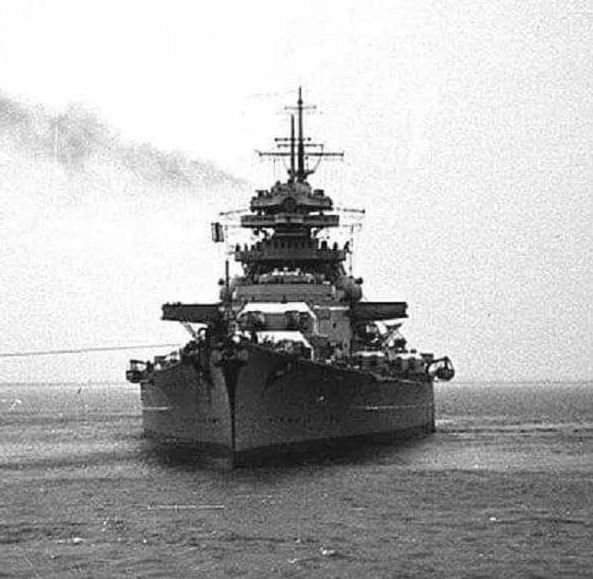The Pursuit and Sinking of the Bismarck
By David Bickerton
David related the tale of the sinking of German battleship Bismarck which was a dramatic episode of World War II. His great interest is because his father was serving on one of the Royal Navy ships.
The end of World War 1 was followed by the Treaty of Versailles in 1919when the victors imposed severe limits on the arms that Germany could have, including warships. Hitler came to power in 1933 and in 1935 negotiated an Anglo-German treaty which allowed the Germans to have 5 capital ships. One of these was the Bismarck, 52,000 tons in weight, carrying eight 15inch guns and launched in 1939, a potentially formidable ship.
In May 1941, nineteen months into the Second World War, the Bismarck and cruiser Prinz Eugen were docked in Poland. The Germans wanted to get them into the North Atlantic to join in the attacks on the convoys supplying Britain. The damage they could have done to Britain being able to survive is almost incalculable. The two ships left the Baltic on the 19th May but were spotted by the Swedes who alerted the British. After a short stop at Bergen, Norway, where they were seen by a British aircraft, they sailed north of Iceland and into the Denmark Strait close to the Greenland icepack. The British cruisers Suffolk and Norfolk saw them on 23rd May. The following morning the 25year old British battlecruiser Hood and brand new light battleship Prince of Wales (with some Camel Laird shipyard workers still on board) reached the Denmark Strait having sailed from the Scapa Flow anchorage in Orkney, and met the two German ships. Everyone opened fire. The Bismarck was hit but the Germans were the more successful. After only eight minutes the lightly armoured Hood was hit, exploded and sank with only 3 survivors from the crew of 1,419 men. The German ships then turned their fire on the Prince of Wales which was badly damaged and limped away after only another two minutes. The loss of the ‘Mighty’ Hood coupled with bad news from Crete was a blow to British morale.
The British ships had damaged the Bismarck and its speed was reduced to22 knots. Captain Lindemann wanted to return to Germany as all surprise had been lost and there was doubt about their continuing fighting ability. He was over-ruled by Admiral Lutjens who ordered him to go to Brest in German held western France and at the same time sent the Prinz Eugen off for independent action. The Suffolk and Norfolk with the Prince of Wales managed to keep shadowing the battleship and late on the 24th May the British commander, Admiral Tovey, got the aircraft carrier Victorious into a position to launch an air attack with nine Swordfish biplanes. In very poor conditions, with heavy cloud, the aircraft launched eight torpedoes. Only one hit the Bismarck doing little damage, but the attack further unsettled the German Admiral. All the Swordfish got back and landed on Victorious.
At 3am on the 25th May the shadowing ships lost radar contact with the Bismarck, and she disappeared. It was not until more than day later at 10.30amon the 26th that a Catalina flying boat sighted the ship. The sighting was confirmed by Swordfish from the aircraft carrier Ark Royal. By now British warships were converging from several directions unknown to the Germans who were confident they could make the remaining 400+ miles to Brest. In the early afternoon Ark Royal launched 14 Swordfish to attack the Bismarck. The weather conditions were atrocious and with only a radar contact the aircraft attacked a ship sailing below the thick cloud. It was the cruiser HMS Sheffield who miraculously was not hit by any of the 11 torpedoes. All the aircraft safely returned to the carrier and were readied for another attack, this time well aware that the Sheffield was closely shadowing the Bismarck. They took off again at7pm in a full gale with heavy rain squalls and the carrier’s deck pitching wildly in the stormy sea. Guided by Sheffield, the 15 Swordfish attacked the Bismarck, flying into a hail of gunfire at only 80 knots. 13 torpedoes were launched but only three hit the German ship, one of which crippled her steering gear and she was seen to turn two complete circles as she reduced speed to about 8 knots. Shortly after 5 ships of the Royal Navy 4th Destroyer Flotilla appeared out of the murk and made repeated torpedo attacks throughout the night. Just before midnight Admiral Lutjens signalled to Hitler that the ship was doomed, but they would fight to the last.
Dawn on the 27th May was clear which did not bode well for the already crippled warship and at 8.30am the British battleships Rodney and King George V appeared from the west and shortly afterwards opened fire. They were joined by the heavy cruiser Dorsetshire which launched torpedoes and the Bismarck sank at 10.40am 300 miles west of Brest. The Dorsetshire and the destroyer Maori stayed to pick up German survivors but did not linger as they were very concerned about the possibility of U-Boat attacks. In all 115survived out of an original crew of more than 2,300.
David said that more than 100 Royal Navy ships were involved in the whole action, and that even today there are unanswered questions. The Bismarck’s companion, the heavy cruiser Prinz Eugen, refuelled at sea and reached Brest on 1st June. It was later involved in the infamous ‘Channel dash’ of February 1942.
Thank you David for your stirring tale of one of WWII’s pivotal actions, which if the Royal Navy had not prevailed might have meant an early end to British resistance to the Germans. War is not a nice business.
During questions, TADS Treasurer Christine revealed that her Father-in-Law was on HMS Suffolk at the time.
Richard Brown
(TADS Newsletter September 2021)


